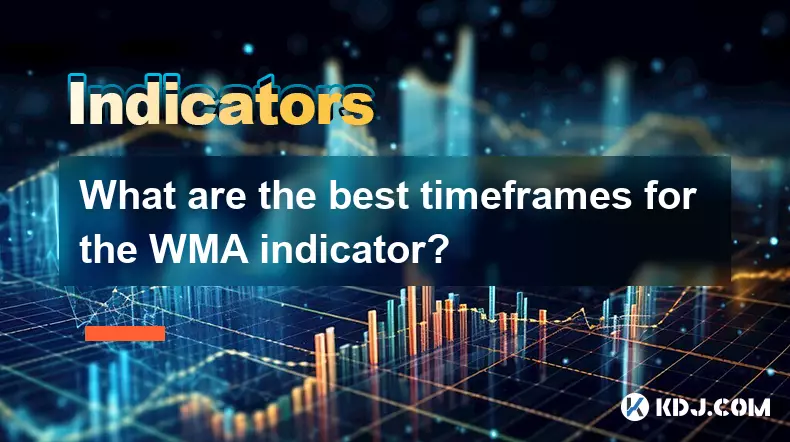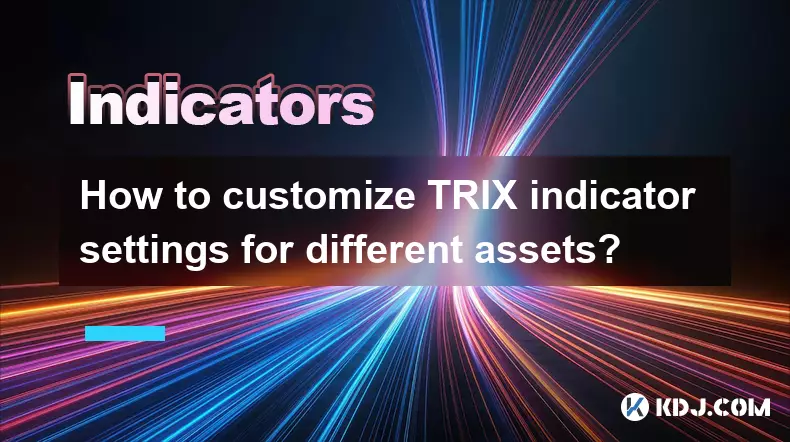-
 bitcoin
bitcoin $100977.009184 USD
-2.05% -
 ethereum
ethereum $3282.009150 USD
-3.23% -
 tether
tether $0.999813 USD
-0.02% -
 xrp
xrp $2.208254 USD
-4.89% -
 bnb
bnb $951.411089 USD
0.55% -
 solana
solana $155.761205 USD
-2.84% -
 usd-coin
usd-coin $1.000217 USD
0.02% -
 tron
tron $0.284475 USD
-1.28% -
 dogecoin
dogecoin $0.162363 USD
-1.53% -
 cardano
cardano $0.533988 USD
-0.47% -
 hyperliquid
hyperliquid $39.174339 USD
-3.22% -
 chainlink
chainlink $14.724828 USD
-1.16% -
 bitcoin-cash
bitcoin-cash $477.297986 USD
-1.28% -
 zcash
zcash $554.227426 USD
17.30% -
 ethena-usde
ethena-usde $0.998995 USD
-0.03%
What are the best timeframes for the WMA indicator?
The Weighted Moving Average (WMA) enhances crypto trading by prioritizing recent prices, offering timely signals across timeframes—from scalping with 5-period WMAs to identifying bull markets using the 200-day WMA.
Nov 07, 2025 at 09:20 am

Understanding the Weighted Moving Average in Crypto Trading
The Weighted Moving Average (WMA) is a technical analysis tool widely used in the cryptocurrency markets to identify trends and potential reversal points. Unlike the Simple Moving Average (SMA), the WMA assigns greater importance to recent price data, making it more responsive to new information. This responsiveness is especially valuable in the fast-moving and volatile environment of digital assets.
Traders rely on the WMA to smooth out price fluctuations and generate signals based on crossovers or divergences. Because crypto markets operate 24/7 and are highly sensitive to news and macroeconomic events, selecting the right timeframe for the WMA can significantly impact trading decisions. The optimal settings depend on the trader’s strategy, risk tolerance, and market conditions.
Best Timeframes for Day Traders
- The 9-period WMA on the 15-minute chart offers timely signals for intraday entries and exits.
- A 20-period WMA on the 1-hour chart helps filter out noise while capturing short-term momentum shifts.
- Combining the 9 and 21 WMAs creates a crossover system that performs well during high-volatility periods like Bitcoin halvings.
- Scalpers often use the 5-period WMA on the 5-minute chart to catch quick moves during exchange listing announcements.
- During major news events, reducing to a 7-period WMA increases sensitivity to sudden price swings.
Optimal Settings for Swing Traders
- The 50-period WMA on the 4-hour chart aligns with medium-term trend direction in altcoin pairs.
- Using both 20 and 50 WMAs together helps identify dynamic support and resistance zones.
- On the daily chart, a 21-day WMA has historically coincided with institutional accumulation phases.
- Altcoins showing price above the 30-day WMA on weekly charts often enter sustained uptrends.
- Divergence between price and the 60-period WMA on the 6-hour chart can signal upcoming reversals.
Long-Term Investment Applications
- The 200-day WMA remains a critical benchmark for determining bull or bear market phases in Bitcoin.
- When Ethereum closes above the 100-week WMA, it often marks the beginning of multi-month rallies.
- Historical data shows that Litecoin tends to bottom near the 150-day WMA during extended corrections.
- A rising 100-day WMA on stablecoins' trading volume charts indicates growing market participation.
- Major breakouts occur when large-cap cryptos sustain prices above the 120-day WMA after prolonged consolidation.
Frequently Asked Questions
How does the WMA differ from the EMA in crypto trading?The WMA applies linear weights to price data, giving the most recent close the highest multiplier. The EMA uses exponential smoothing, which reacts even faster to price changes. In highly volatile crypto markets, the EMA may produce more false signals during sideways movement, while the WMA offers a balanced compromise between responsiveness and stability.
Can the WMA be used effectively during low-volume periods?Yes, but with caution. During weekends or holiday lulls in trading activity, the WMA may flatten and generate misleading crossovers. It's advisable to widen the period setting—such as using a 30-period instead of 9-period WMA—to reduce noise. Volume confirmation should accompany any WMA-based signal under these conditions.
Which cryptocurrencies respond best to WMA strategies?High-liquidity assets like Bitcoin, Ethereum, and Binance Coin tend to follow WMA trends more reliably due to deeper order books and less manipulation. Low-cap altcoins with erratic volume often violate WMA support/resistance levels without follow-through, making them less suitable for pure WMA-based approaches.
Is the WMA effective across different exchange platforms?The mathematical calculation of the WMA remains consistent across exchanges. However, differences in tick data precision, candlestick aggregation methods, and API update speeds can cause minor variations in plotted values. Traders executing high-frequency strategies should verify WMA alignment between their charting software and exchange feed to avoid execution gaps.
Disclaimer:info@kdj.com
The information provided is not trading advice. kdj.com does not assume any responsibility for any investments made based on the information provided in this article. Cryptocurrencies are highly volatile and it is highly recommended that you invest with caution after thorough research!
If you believe that the content used on this website infringes your copyright, please contact us immediately (info@kdj.com) and we will delete it promptly.
- BlockDAG, Avalanche, Dogecoin: Crypto's Leading Trio in 2025
- 2025-11-07 22:05:01
- Layer 2 Coins: Will There Be a Potential Explosion by 2026?
- 2025-11-07 16:50:02
- Filecoin, ICP, and the AI Infrastructure Renaissance: Is History Repeating?
- 2025-11-07 16:50:02
- Bitcoin's Wild Ride: Surges, Zeros, and the Search for Stability
- 2025-11-07 17:05:01
- XRP, Bitcoin, and the Rally: What's the Deal, New York?
- 2025-11-07 17:25:01
- Filecoin, DePIN, and a Technical Breakout: What's the Buzz?
- 2025-11-07 17:05:01
Related knowledge

How do professional traders use the TRIX indicator?
Nov 06,2025 at 04:40pm
Understanding the TRIX Indicator in Crypto TradingThe TRIX (Triple Exponential Average) indicator is a momentum oscillator used by professional trader...

Can I use the TRIX indicator on my mobile trading app?
Nov 07,2025 at 07:40pm
The TRIX indicator, a momentum oscillator designed to filter out short-term fluctuations and highlight long-term trends, has become increasingly popul...

How to code a simple TRIX indicator script in Pine Script?
Nov 07,2025 at 06:20am
How to Code a Simple TRIX Indicator in Pine Script The TRIX (Triple Exponential Moving Average) indicator is widely used in cryptocurrency trading to ...

How to trade TRIX indicator signals on the 1-hour chart?
Nov 07,2025 at 05:39am
Bitcoin's Role in Decentralized Finance1. Bitcoin remains the cornerstone of decentralized finance, serving as a benchmark for value and security acro...

Can the TRIX indicator be used for long-term investing?
Nov 06,2025 at 02:19pm
Understanding the TRIX Indicator in Cryptocurrency Markets1. The TRIX (Triple Exponential Average) indicator is a momentum oscillator designed to filt...

How to customize TRIX indicator settings for different assets?
Nov 06,2025 at 03:39pm
Understanding the TRIX Indicator in Cryptocurrency Trading1. The TRIX (Triple Exponential Average) indicator is a momentum oscillator designed to filt...

How do professional traders use the TRIX indicator?
Nov 06,2025 at 04:40pm
Understanding the TRIX Indicator in Crypto TradingThe TRIX (Triple Exponential Average) indicator is a momentum oscillator used by professional trader...

Can I use the TRIX indicator on my mobile trading app?
Nov 07,2025 at 07:40pm
The TRIX indicator, a momentum oscillator designed to filter out short-term fluctuations and highlight long-term trends, has become increasingly popul...

How to code a simple TRIX indicator script in Pine Script?
Nov 07,2025 at 06:20am
How to Code a Simple TRIX Indicator in Pine Script The TRIX (Triple Exponential Moving Average) indicator is widely used in cryptocurrency trading to ...

How to trade TRIX indicator signals on the 1-hour chart?
Nov 07,2025 at 05:39am
Bitcoin's Role in Decentralized Finance1. Bitcoin remains the cornerstone of decentralized finance, serving as a benchmark for value and security acro...

Can the TRIX indicator be used for long-term investing?
Nov 06,2025 at 02:19pm
Understanding the TRIX Indicator in Cryptocurrency Markets1. The TRIX (Triple Exponential Average) indicator is a momentum oscillator designed to filt...

How to customize TRIX indicator settings for different assets?
Nov 06,2025 at 03:39pm
Understanding the TRIX Indicator in Cryptocurrency Trading1. The TRIX (Triple Exponential Average) indicator is a momentum oscillator designed to filt...
See all articles





















![The Graph Price Prediction [GRT Crypto Price News Today] The Graph Price Prediction [GRT Crypto Price News Today]](/uploads/2025/11/07/cryptocurrencies-news/videos/690d4df44fe69_image_500_375.webp)




















































